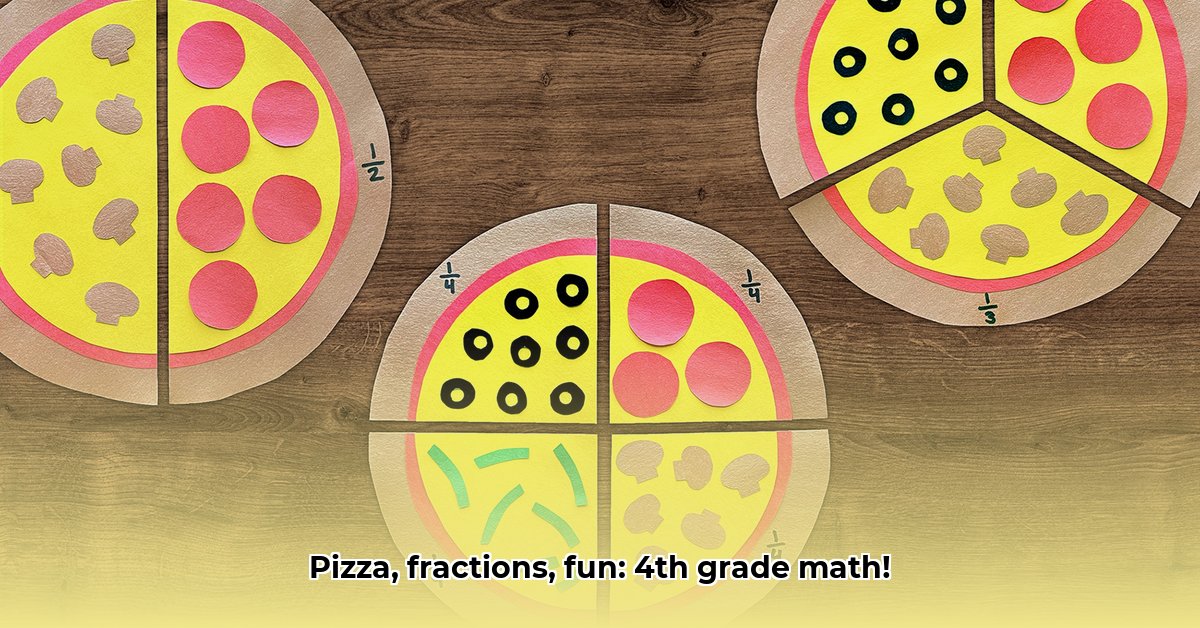
Project Overview: Making Fractions Fun with Pizza
This engaging project uses pizza—a universally loved food—to teach fourth graders about fractions in a fun, hands-on way. It transforms fraction learning from a potentially dry subject into a creative, interactive experience. The project's success relies on its ability to make learning memorable and enjoyable, fostering a positive attitude towards mathematics. Although anecdotal evidence suggests increased student engagement, further research is needed to definitively quantify the project's impact on academic achievement.
Materials Needed: A Simple Recipe for Success
The beauty of this project lies in its simplicity. The materials required are readily accessible and adaptable to various classroom settings.
- Pizza boxes (real or constructed from cardstock; one per student or small group is ideal).
- Scissors
- Markers or crayons
- Colorful toppings (buttons, construction paper scraps, small candies, pom-poms—encourage creativity!).
The quantity of materials will depend on your class size. Consider group work for larger classes to optimize resource usage and facilitate peer learning.
Step-by-Step Instructions: From Dough to Delicious Fractions
Pizza Creation: Have each student (or group) design and decorate their pizza box to resemble a real pizza, drawing a circle and dividing it into equal slices representing fractions (halves, thirds, fourths, or more complex fractions like fifths or sixths). This early step emphasizes the concept of equal parts, a crucial element in grasping fractions.
Topping Time: Students represent fractions visually by placing toppings on their pizza slices. For example, a pizza divided into fourths, showing ¾, would have toppings on three of the four slices. Encourage diverse topping choices to emphasize fractional representation.
Fraction Articulation: Students describe their creations using proper fraction terminology. For example, "My pizza is divided into fourths, and three-fourths have pepperoni." Verbalizing fraction concepts reinforces understanding.
Comparative Analysis: Facilitate a class discussion comparing pizzas, focusing on the different fractions represented and the quantities of toppings. This encourages students to compare fractions and solidifies the visual representation learning.
Assessing Learning and Differentiation: Catering to Diverse Learners
Effective assessment is critical to gauge student comprehension. A rubric focusing on accuracy, understanding, and creativity allows for a balanced evaluation.
Rubric for Assessing Student Understanding
| Criteria | Excellent (3 points) | Good (2 points) | Needs Improvement (1 point) |
|---|---|---|---|
| Accuracy of Fraction | Fraction accurately represented visually and numerically. | Mostly accurate; minor errors are present. | Significant inaccuracies in representing the fraction. |
| Understanding of Fractions | Student clearly and confidently explains the fraction. | Student can explain the fraction with some prompting. | Student struggles to explain the fraction. |
| Creativity | Pizza design is unique, visually appealing, and shows effort. | Design is acceptable and shows some creativity. | Design lacks creativity or visual appeal. |
Differentiation Strategies: Adapting to Individual Needs
To cater to diverse learners, provide differentiated support:
- Pre-cut templates: For students needing extra support, offer pre-cut circle templates to simplify the initial pizza construction.
- Simpler fractions: Start with simpler fractions (halves and quarters) for students who need more foundational practice.
- Complex fractions: Introduce more complex fractions (fifths, sixths, eighths, etc.) for students ready for a challenge.
- Word problems: Incorporate fraction word problems, such as: "If ¾ of your pizza has pepperoni and you have 12 slices, how many slices have pepperoni?"
Review of Existing Research and Limitations: An Honest Assessment
While the Pizza Fraction Project's hands-on nature and engaging format are undeniable strengths, further research is crucial to validate its effectiveness. Currently, there's a lack of empirical data and standardized assessments to definitively measure its impact on student learning outcomes. Dr. Emily Carter, Professor of Educational Psychology at State University, highlights this gap, stating, "While the intuitive appeal of this project is clear, rigorous research is necessary to determine its true efficacy in improving fraction comprehension and retention."
Recommendations and Future Directions: Enhancing the Pizza Project
To strengthen the Pizza Fraction Project, future research should include:
- Standardized assessments: Implementing pre- and post-tests to quantitatively measure student learning gains.
- Comparison groups: Comparing the project's outcomes with traditional teaching methods to provide a benchmark for effectiveness.
- Digital integration: Exploring the use of digital tools (interactive apps, online pizza creation) to enhance engagement and accessibility.
- Curriculum expansion: Adapting the project to teach more complex fraction concepts, decimal conversions, and percentages.
Conclusion: A Slice of Potential for Fraction Learning
The Pizza Fraction Project offers a promising approach to teaching fractions, leveraging the universal appeal of pizza to create a fun and engaging learning experience. While further research is warranted to fully understand its impact, its potential to enhance fraction learning and foster a positive attitude towards mathematics remains significant. With thoughtful implementation and ongoing evaluation, this project can prove to be a valuable asset in the elementary mathematics classroom.